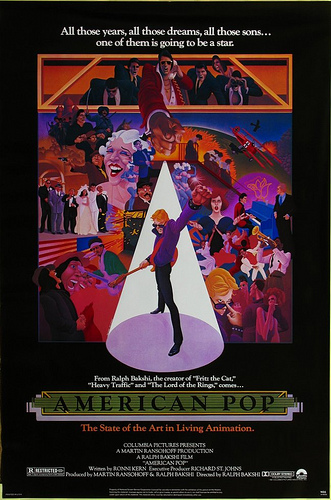
American Pop focuses on four generations of Americans striving to make it in the music business.
By Scott A. Cupp
This is the 169th in my series of Forgotten, Obscure or Neglected Films
Recently, I purchased some DVD’s of films I had been wanting for some time. They included Sorority Babes at the Slimeball Bowl-o-Rama (reviewed a couple of weeks ago), Quatermass and the Pit (soon to be on the list) and this week’s pick, American Pop.
I first encountered Ralph Bakshi’s work on the Saturday morning Spider-Man cartoon of the late 1960’s. It didn’t really do much for me then, but I watched because … Spider-Man. I had a strong emotional attachment to that nerdy character at the time. Fritz the Cat came out a few years later, but it would be a while before I finally saw that film. X rated animated features were not high on my list at that time.
Then came Wizards. That one resonated! Wow! Rotoscoping genius. I had earlier seen rotoscoping in some of the Fleischers’ work — the Popeyes (particularly the Sinbad one) and Gulliver’s Travels. In Wizards, animation was making a new old leap forward. Then The Lord of the Rings! Yep, Frodo and Gandalf were on the big screen in a way I never expected to see them. Rotoscoping allowed for some realism in the content, but it had its problems too. Unfortunately, Bakshi’s LOTR was not complete and the second half never did arrive in theaters. Several stories emerged as to why it did not, especially since the first film did well at the box office. There was later a Rankin-Bass adaptation of The Return of the King which supposedly completed the film. I own a copy but have never watched it. I am not a fan of Rankin-Bass.
Anyway, American Pop was Bakshi’s next project, and it was near and dear to my heart. It presents a guide to American popular music for the first eight decades of the 20th Century. It tells the story of four generations of a Russian Jewish family who immigrated to the New York City area during the pogroms of the Czarist era. Zalmie Belinski (voiced by Jeffrey Lippa) begins working in the vaudeville halls prior to World War I, passing out chorus lists to patrons so they can sing along with the performers. His mother works in a garment-district sweatshop and is killed in one of the deadly fires that happened during that period.
Zalmie continues in vaudeville, hoping to be a singer. He meets a young stripper, Bella (voiced by Lisa Jane Persky), and soon finds himself with a son on the way and urged by the local mob to marry Bella. He joins a vaudeville tour of the war zone as the back half of a dancing horse act and, in a freak accident, is shot in the throat. He will now never be a singer. Bella, however, has some success.
Zalmie’s mentor, Louie, is working for Mr. Palumbo, the mobster, and Zalmie finds himself working for him too. It is the time of speakeasies and Prohibition and mob wars. Palumbo needs a husband for his daughter and Zalmie’s son, Bennie (Richard Singer), an aspiring jazz pianist, is recruited. When WWII breaks out, Bennie enlists even though he has a child on the way. In a poignant scene, Bennie finds a piano in a bombed out village. He puts his gun down and starts playing. A wounded German soldier is nearby and approaches Bennie. Bennie plays Lili Marleen for the soldier who is obviously reminiscing about better days. When Bennie finishes, the soldier kills him.
Bennie’s son Tommy (Ron Thompson) grows up in the late 50’s and early 60’s, joining the Beat scene. There is a wonderful performance of the first part of Ginsberg’s Howl in one of the clubs. Tommy splits, steals a car, and makes it to Kansas, where he has a one night stand with a waitress. He soon arrives in California during the birth of the Summer of Love, where he meets Frankie Love (Marya Small) and her band, modeled off several Bay Area bands but most notably Jefferson Airplane and Big Brother and the Holding Company.
This is where the film really works for me because this is my music. The Golden age for Rock and Roll is 15. The music you liked at 15 is the stuff that stays with you. For me, 15 was the Summer of Love. The Airplane, the Electric Prunes, the Doors, Hendrix, Cream — they were the magic for me.
Bakshi takes the film up to the punk scene and the re-emergence of Bob Seger. I was not much of a fan of that final stage of the story because the story focuses heavily on drug dealing, but I still liked the music.
Overall, I had fun with this again. I had seen it in 1981 but not since. I loved the music. The animation was OK. As I said, rotoscoping has some drawbacks, but overall it worked. Give it a try. It has some wonderful mixed-media influences, including the use of archival footage that was not animated.
As always (and particularly where music is involved), your mileage can vary significantly from mine. If you hate rock and roll, the last half hour will not be your cup of tea. For me, though, it was oolong.
Series organizer Todd Mason host Tuesday Forgotten Film reviews at his own blog and posts a complete list of participating blogs.
